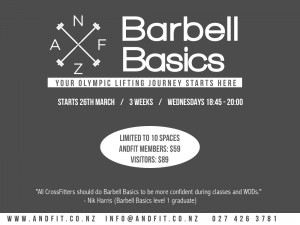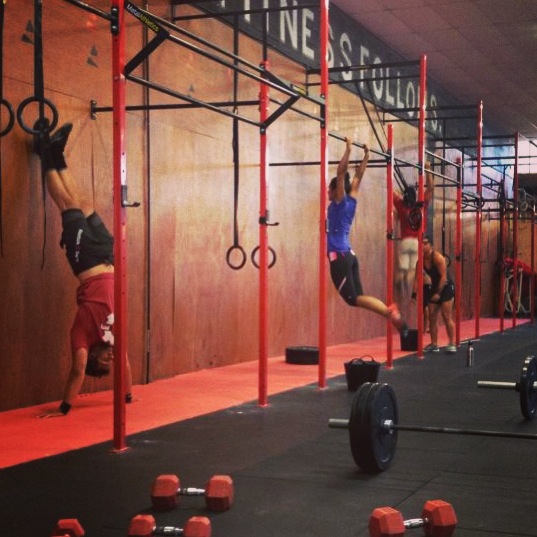 We have another round of our 3 session Olympic lifting course starting on the 26th of March. There are only 5 spaces left so email [email protected] if you are keen to jump in!
We have another round of our 3 session Olympic lifting course starting on the 26th of March. There are only 5 spaces left so email [email protected] if you are keen to jump in!
Workout of the day:
OPEN WOD 14.2 and/or 2km Row for time
Every 3 minutes for as long as possible complete:
From 0:00-3:00
2 rounds of:
10 overhead squats
10 chest-to-bar pull-ups
From 3:00-6:00
2 rounds of:
12 overhead squats
12 chest-to-bar pull-ups
From 6:00-9:00
2 rounds of:
14 overhead squats
14 chest-to-bar pull-ups
Etc., following same pattern until you fail to complete both rounds
MEN - includes Masters Men up to 54 years old
42.5KG. overhead squats
Chest-to-bar pull-ups
WOMEN - includes Masters Women up to 54 years old
30KG. overhead squats
Chest-to-bar pull-ups
MASTERS MEN - includes Masters Men 55+
30KG. overhead squats
Chin-over-bar pull-ups
MASTERS WOMEN - includes Masters Women 55+
20KG. overhead squats
Jumping chest-to-bar pull-ups
Some advise on this workout from Rudy Nielsen:
I never thought I’d see the day. Legit WORK:REST intervals in an Open workout, and enough scientific strategerizing to keep me up reading NSCA manuals all night.
Outlaw Strategy and pacing tips for 14.2:
-Hold your WORK:REST for as long as possible.
If any of you watched the announcement show (which I’m sure you all did), you noticed a distinct difference in strategy and a distinctly different result. Talayna broke the C2B relatively early, made fast work of the OHS, and continued to battle well into the round of 20. This is no surprise considering the overall metabolic impact of large sets of C2B pull-ups, and the large toll they take on the localized musculature that is used to perform them. Camille went unbroken too long, and they failed quickly. The beauty of this workout is that there’s plenty of space for those short work:rest intervals.
After testing and hearing feedback, we are going to suggest completing each round as if it is a 1:30 interval, and breaking the C2B early and often. Yes, many of you don’t NEED to break the rounds of 10 & 12, but breaking them will stave off the dreaded lactic acid monster and keep you moving longer. Each round should basically be used to recover as much as possible. If you have 90 seconds to work with, and 10 OHS take between 18 and 20 seconds, then you have another 70 seconds to complete 10 seconds work. With a degree of variability, 10 C2B take 10 seconds – obviously this is with a butterfly, but it should hold fairly close for most athletes. This means you have ALOT of time to complete 10 reps. My suggestion would be two sets of five, with enough rest to give you 10 seconds to transition back to the OHS.
The work:rest intervals don’t even really fall off much deeper into the workout. Talayna’s first set of OHS on the round of 18 were around 35 seconds, this means she had 55 seconds to complete 18 seconds worth of work. That is STILL a 1:2 work to rest cycle, which is the same one we had our athletes hold on the 100s workout at Regionals last year with great success. Yes, this implies that your OHS have to be smooth and unbroken, but even if you fall to a 45 second round you still have more than a 1:1 cycle to work with.
-Save your grip, save your score.
I alluded to using two sets of five on the first round of C2B, let me elaborate on that with some suggestions… When I say sets of 5 on that round, I mean sets of 5 or less on every round (FOR INSTANCE: 5-5-4 on the round of 14). This is am absolute grip killer, and even if you have a massive UB set of C2B, the small sets remain as the suggestion. Resting or breaking on C2B does not take long. There is no barbell to pick up, and get in place, and nothing to slow you down but raising your arms back up. This, combined with the built in time allotted for work:rest, allows for a saving of grip that will be a necessity in the later rounds. No matter what, the forearms will fill up with lactic acid first as they are the smallest muscle group utilized in the C2B. Therefore, small sets not only allow for less overall fatigue, but they also allow for a quick opportunity to relieve grip and save it for deeper into the piece.
-Speaking of grip, save your hands too.
Caleb Williams just performed 14.2. He ripped for the first time in almost two years, and felt if he hadn’t he would have easily advanced to the next round. Obviously, you cannot rip. I would test every possible hand protection that is allowed for this piece. If you rip, the workout is basically over. This means you need to be prepared to be a little uncomfortable if you’ve never worn hand protection, and may be able to take it off at some point if it’s really bothering you.
-Wear Weightlifting shoes.
Please don’t tell me they’re too heavy. PLEASE. Wear them as they will allow no issues with depth, and a bounce out of the bottom to engage the stretch shortening cycle. If you’re worried about being “too heavy”, make yourself puke out the extra 15 ounces that’ll be on your feet before you start. Stability is more important than 15 ounces.
-Transitions are massive.
I always feel bad for the athletes that perform on the announcement show because they have to adhere to the staging of the workout. If you don’t have to be on a made for TV event, you need to have everything within a one step radius. Chalk, BB, pullup bar, and even a clock for intervals. Leave every second for rest, not wandering around the gym looking for chalk.
-Don’t rush your first rep of OHS, and try narrowing your grip.
I know this may sound like heresy, but I don’t think it’s particularly important to catch the snatch in a full squat. I like to power snatch, get my feet set, then go. If you won’t possibly fumble the full snatch, have at it, but you cannot waste energy trying to be fast. Also, I can’t say this strongly enough (hopefully people are still reading), you may gain a giant advantage by narrowing your grip to save shoulder fatigue. It is simply more stressful to hold a bar OH for a long period of time with a wide grip. If you can narrow your hands it will help stave off shoulder fatigue that could force you to drop the bar before you need to.
-Should you repeat?
No.
One and done on this one boys and girls, unless you like hospitals.
